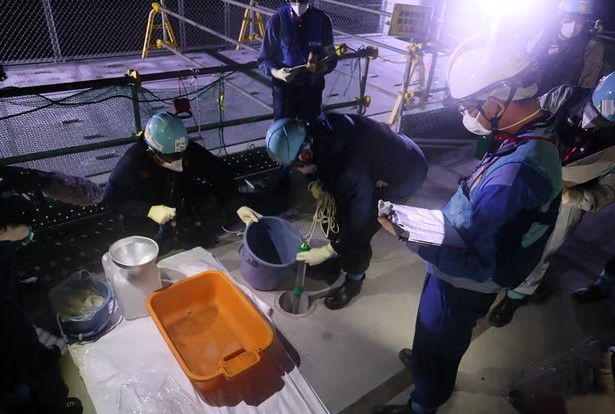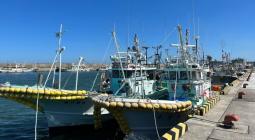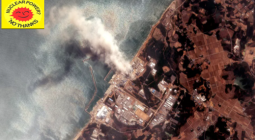China bans Japanese seafood after Fukushima wastewater release

Water containing radioactive tritium being pumped into Pacific via tunnel from Tepco plant, amid protests from China, South Korea and fishing communities.
Japan has begun discharging more than 1m tonnes of tainted water into the Pacific Ocean from the wrecked Fukushima Daiichi nuclear power plant in a move that has prompted China to announce an immediate blanket ban on all seafood imports from Japan and sparked anger in nearby fishing communities.
The plant’s operator, Tokyo Electric Power (Tepco), pumped a small quantity of water from the plant on Thursday, two days after the plan was approved by Japan’s government.
Tepco said the release began at 1:03pm local time (0403 GMT) and it had not identified any abnormalities with the seawater pump or surrounding facilities. Live video showed engineers behind computer screens and an official saying – after a countdown – that the “valves near the seawater transport pumps are opening.”
Monitors from the UN atomic watchdog, which has endorsed the plan, were due to be on site for the procedure, while Tepco workers were scheduled to take water samples later on Thursday.
The discharge, which is expected to take 30 to 40 years, has caused anger in neighbouring countries and concern among fishers that it will destroy their industry as consumers steer clear of seafood caught in and around Fukushima.
On Thursday, China’s customs agency announced it would “completely suspend the import of aquatic products originating in Japan”, effective immediately, in order to “prevent the risk of radioactive contamination of food safety”.
The Chinese government has been highly critical of the planned water release, branding it “extremely selfish and irresponsible”.
“The ocean is the common property of all humanity, and forcibly starting the discharge of Fukushima’s nuclear wastewater into the ocean is an extremely selfish and irresponsible act that ignores international public interests,” Beijing’s foreign ministry said in a statement.
It warned of a potential “man-made secondary disaster to the local people and the whole world” following the original 2011 Fukushima disaster.
“By dumping the water into the ocean, Japan is spreading the risks to the rest of the world and passing an open wound onto the future generations of humanity.”

On Thursday, South Korean police arrested at least 14 people who entered a building housing the Japanese embassy in Seoul during a protest against the release, an organiser and a Reuters witness said.
The water will initially be released in modest quantities and with extra checks, Tepco said, with the first discharge, totalling 7,800 cubic metres, expected to last about 17 days. The utility will start the release “carefully and from a small amount”, an official in charge of the processed water said.
How to dispose of wastewater that has built up at the site on Japan’s north-east coast has proved a diplomatic headache for the government, despite support for its approach from the UN’s nuclear watchdog, the International Atomic Energy Agency (IAEA).
The water became contaminated after it was used to cool three nuclear reactors that melted down after Fukushima Daiichi was struck by a powerful tsunami in March 2011. The waves knocked out the plants backup electricity supply and forced the evacuation of 160,000 people, in the world’s worst nuclear accident since Chornobyl.
On-site technology is used to remove most harmful substances, but it is unable to filter out tritium, a radioactive isotope of hydrogen that is considered to be relatively harmless because, according to Tepco, it emits very weak levels of radiation and does not accumulate or concentrate inside the human body.
Critics of the discharge say a lack of long-term data means it is impossible to say with certainty that tritium poses no threat to human health or the marine environment. Greenpeace said the radiological risks had not been fully assessed, and that the biological impacts of tritium, carbon-14, strontium-90 and iodine-129 – which will be released as part of the discharge – “have been ignored”.

Ahead of Thursday’s release, Tepco said the first batch of discharged water would contain about 190 becquerels of tritium per litre – well below the World Health Organization drinking water limit of 10,000 becquerels per litre. The water will be released at a maximum rate of 500,000 litres (132,000 US gallons) a day.
Japanese officials say the water – which is being diluted with seawater before being pumped into the Pacific via an undersea tunnel – is safe. That view was backed by a recent IAEA safety review in which it said the release would have a “negligible” radiological effect on people and the environment.
But assurances over food safety have failed to convince China. Hours before the discharge was due to begin, Chinese foreign ministry spokesperson Wang Wenbin called the move “extremely selfish”, adding that Beijing had lodged a formal complaint with Japan’s ambassador to China.
Wang said China would “take all necessary measures to protect the marine environment, food safety, and public health. “The ocean is the common property of all humankind, not a place for Japan to arbitrarily dump nuclear-contaminated water,” Wang said.
An article in the English-language edition of the state-run Global Times accused Japan’s prime minister, Fumio Kishida, of opening a Pandora’s box by approving the release. “What will be unleashed once the Pandora’s box is open?” the newspaper said. “The answer to this question may become a landmine threatening the ecological environment of the world and the fears of real-life Godzilla among the public worldwide.”
China banned imports of food and agricultural products from five Japanese prefectures soon after the 2011 triple disaster, and later widened its ban to cover 10 of Japan’s 47 prefectures.
Hong Kong’s chief executive, John Lee, said releasing the water into the ocean was “irresponsible”, adding that the city would activate import controls on Japanese seafood from regions including Fukushima and Tokyo from Thursday. The ban will cover live, frozen, refrigerated, and dried seafood, as well as sea salt and seaweed.
South Korea, once an outspoken critic of the plans, has said that it accepts the science behind the discharge, but has stopped short of publicly supporting Japan’s approach amid concerns over food safety among the South Korean public.
Some experts have pointed out that nuclear power plants in other countries, including China, release diluted tritium into the sea for decades without incident.
“Nuclear power plants worldwide have routinely discharged water containing tritium for over 60 years without harm to people or the environment, most at higher levels than planned for Fukushima,” Tony Irwin, an honorary associate professor at the Australian National University, said.
Photograph: Chung Sung-Jun/Getty Images - A South Korean protester is detained by police outside the Japanese embassy in Seoul on Thursday after Japan began releasing wastewater from the ruined Fukushima nuclear power plant.





